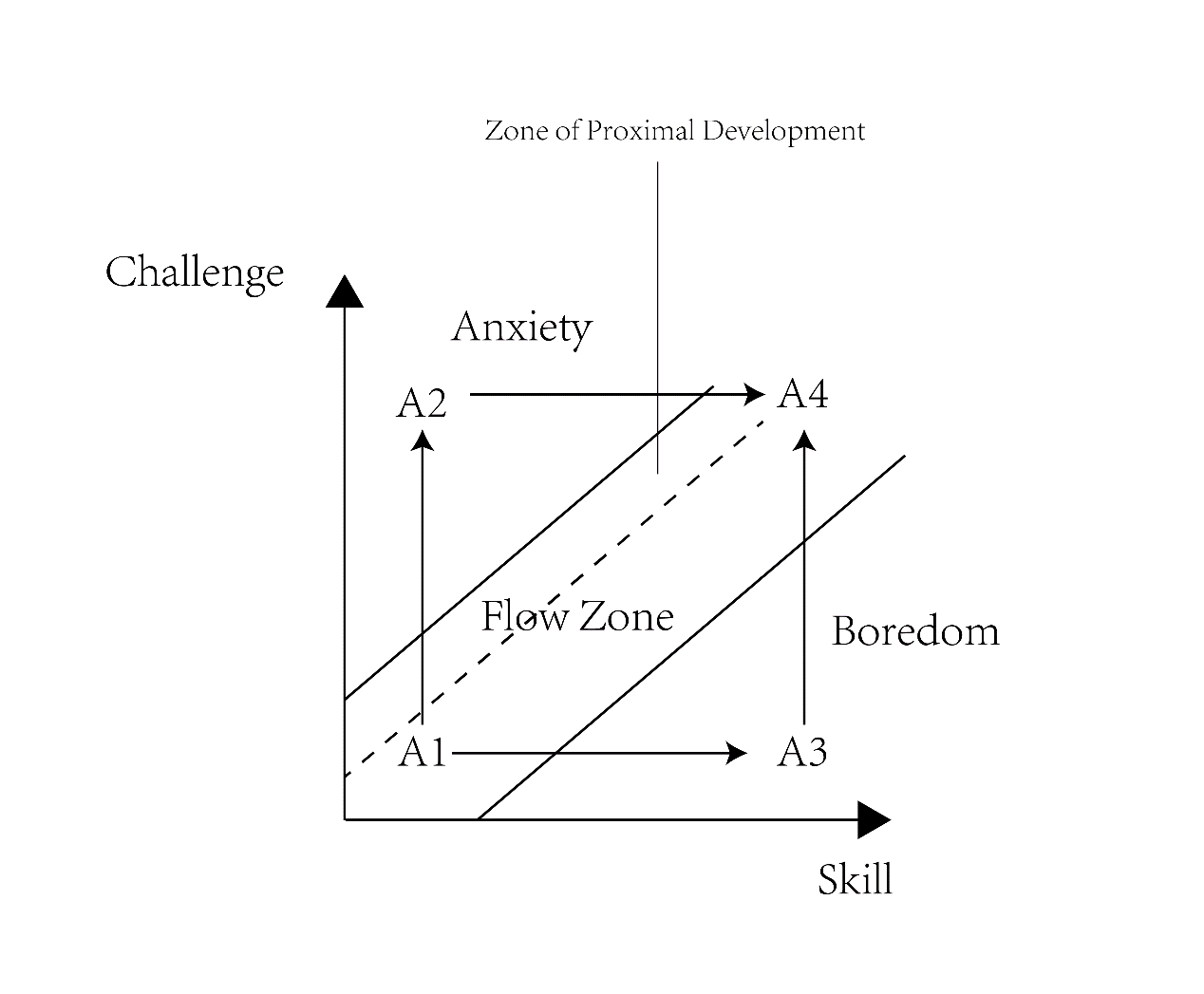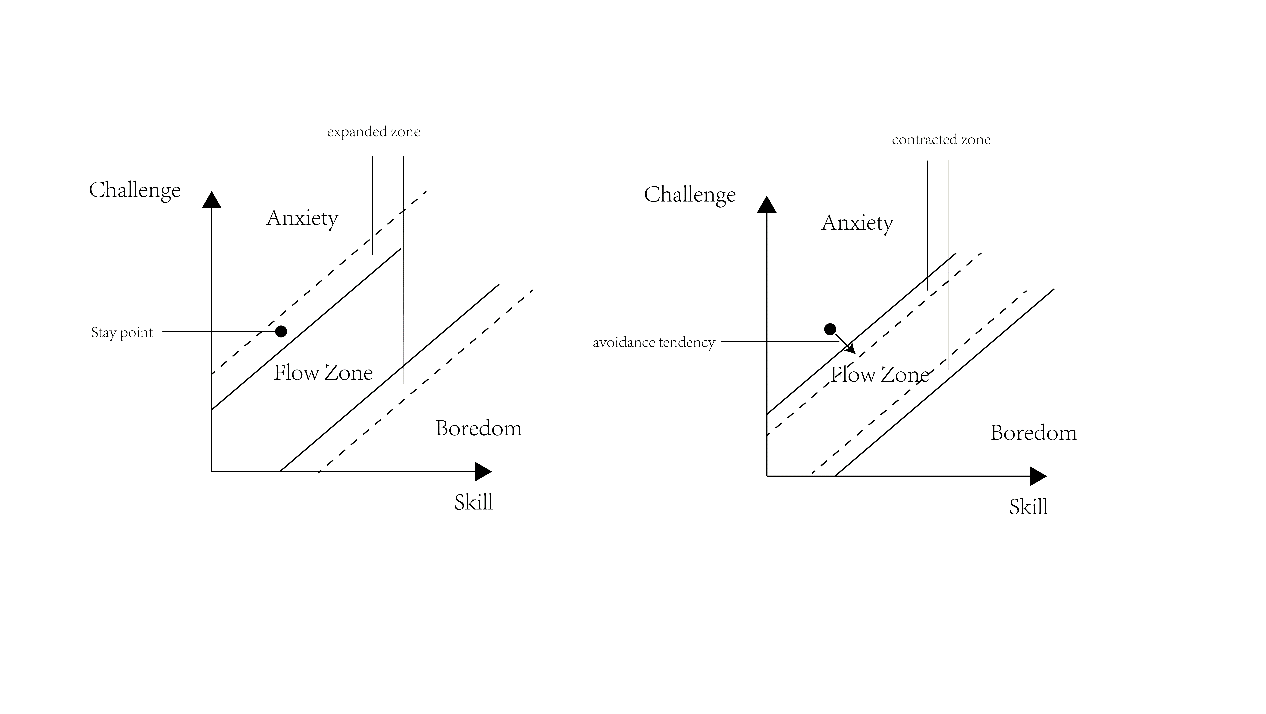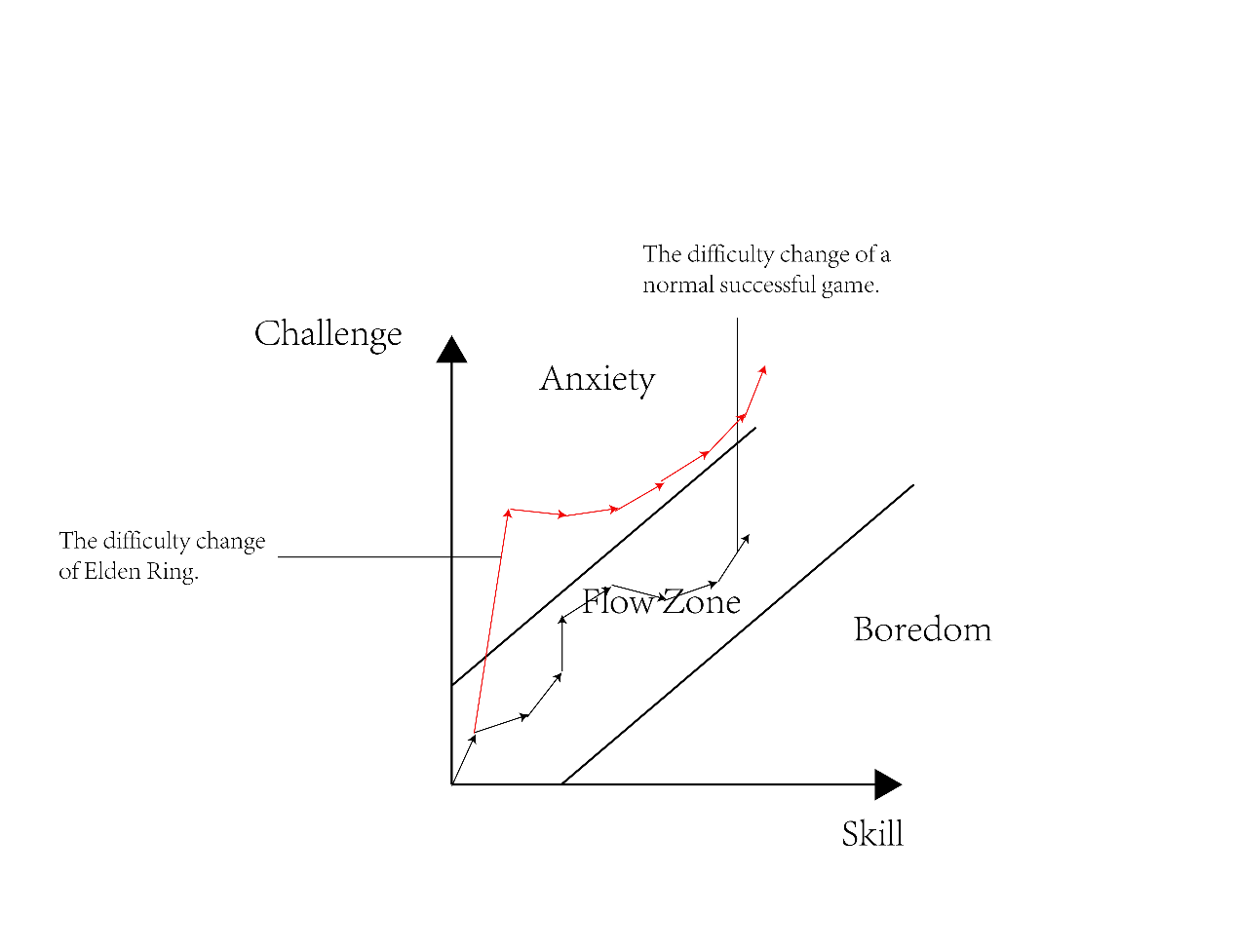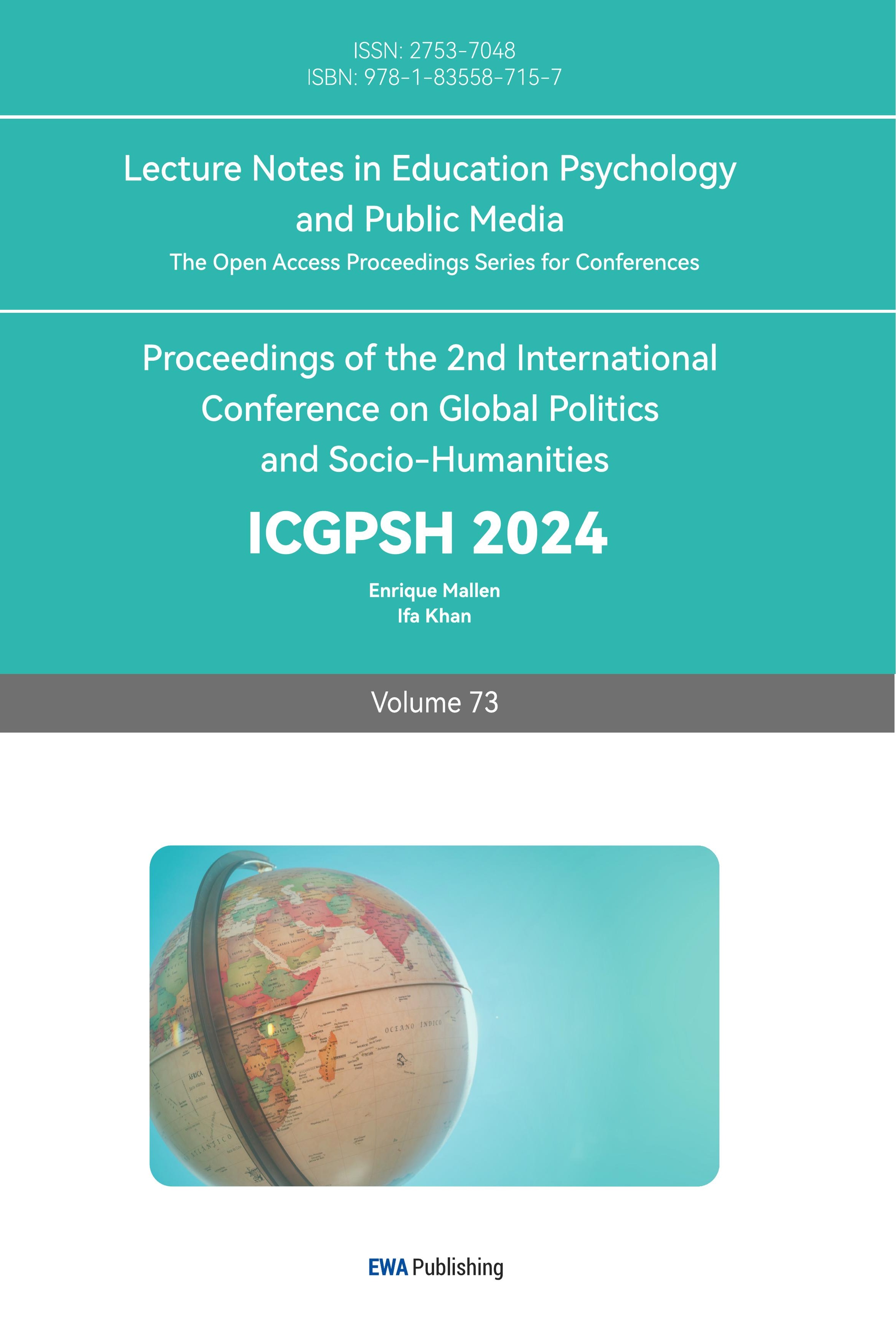1. Introduction
As playing games becomes increasingly popular, the corresponding psychology is also well developed. Scientists began to consider why the people like to play games and the value that game brings to the people. Experience suggests that “happiness” may be one of the key factors. In 1970, Csikszentmihalyi raised a concept called “flow”, which is connected to happiness, creativity, and subjective well-being [1]. The mainstream of the research on the combination of flow theory and game design is about how the flow can help game-based learning. Kiili used flow framework to analyze an educational business game and find guidance to the educational game design [2-3]. Similarly, Admiraal used the concept of flow to analyze the students’ game performance and learning outcomes in a history game.
Before addressing these issues, determining whether a person is having a flow experience is actually not something that can be easily tested. Csikszentmihalyi identified nine factors of flow [1]. The revised Flow State Scale-2 (FSS-2) and Dispositional Flow Scale-2 (DFS-2) were developed by Marsh and Jackson to test the flow experience among athletes [4-5]. Based these nine factors, electroencephalogram and neural science was also used to assess the flow state of game players based on the change of their brain activities [6-7]. Procci’s research suggests that DFS-2 based on 9 factors is not suitable for the game flow experience, so they re-match it into 7 factors [8], which indirectly confirms the ambiguity of test flow experience. In general, this article will not strictly distinguish whether a person is in the flow zone.
This paper will begin the topic with a developed model based on Csikszentmihalyi’s challenge/skill balance model [1], and then use the model on analyzing a popular game, Elden Ring. In the end, the model will be verified by interviewing some players about their flow experience. By this process, this paper can not only give an intuition to the game designer about how to provide more flow experience to the players, but also inspire people with methods to expand the flow zone in normal life.
2. Related work
To elaborate on the conditions of flow, Csikszentmihalyi first creates a model of challenge/skill balance [1]. This model shows a dynamic process when people are experiencing flow. The main influencing factors are challenge and skill. Excessive amounts of either factor will disrupt the balance. For instance, if people's skill is significantly higher than the challenge they are facing, they will feel bored, and this kind of emotion will distract them from the flow zone. Similarly,, if the challenge is greater than the skill, people will feel anxiety and they will also be pulled out of their flow experience. However, when people are outside of their flow zone, it does not mean that they cannot return to it. People can increase their challenge or skill depending on different situations and get back into their flow zone again, but with a higher skill and challenge balance. As shown in Figure 1, this dynamic process not only elucidates the mechanisms by which individuals transition into and out of the flow state but also how the flow experience facilitates personal growth and discovery[1].

Figure 1: Csikszentmihalyi’s model and Vygotsky’s zone of proximal development
However, challenge and skill are not clearly defined variables in practice and are not even entirely objective. Challenges are perceived subjectively perceived, and different people may perceive the same thing in completely different ways. Likewise, skills also depend on how we view ourselves. Conquering a steep mountain may not be a challenge for some people, but these same individuals may find it extremely difficult to play some very simple music. In general, both subjective and objective conditions influence flow activities. [9]
This implies that the flow zone is a variable for different people, and even for the same person in different fields. Vygotsky’s zone of proximal development (ZPD) gives a correction to this model, and it’s also shown in Figure 1.[10] With guidance or collaboration with others, the flow zone can be extended wider. This means that with the same skill level, people can handle more challenges and still remain in the flow zone. This kind of experience may occur in everyone’s daily lives. For instance, in the class or studying group, students are able to handle more challenging problems than at home alone. Moreover, in many situations the teacher doesn’t give the answer directly, but the students are still facing harder problems without anxiety. This phenomenon confirms Csikszentmihalyi’s opinion, that skills and challenges are influenced to some extent by subjective factors, which in turn vary with changes in the environment, such as guidance and collaboration. ZPD gives a probability of the extension of the flow zone, whereas the environmental factors are not what this paper wants to focus on.
3. New model
This paper raises a new model, that people’s flow zone will gradually extend wider if they keep staying out of their original flow zone, and on the contrary, their flow zone will shrink if they keep evading from the outside area of their flow zone. (Figure 2) For the example of ZPD, the students are likely to gain confidence in solving more challenging problems with the guidance of the teacher, and they are more likely to face the same difficult problems on their own when they return home. This reflects extension in their flow zone, whereas it happens after the guidance, so it can’t be simply characterized into ZPD. The whole process happens naturally and doesn’t occur the clear objectively skill or challenge change mentioned by Csikszentmihalyi, meaning that the zone extension is more fundamentally.

Figure 2: New model of expanded and contracted zone
Fundamentally, the subjective factors in pulling out of the “flow zone” are skill and challenge, while the objective factor is emotion. Csikszentmihalyi repeatedly mentioned that whenever skills and challenges are not in balance, people will become bored or anxious and then fall out of the flow zone. For the example in case of Vygotsky’s ZPD, the objective difficulty of the problem doesn’t change, and a student’s test score may be the same in the next exam, but with the teacher's guidance, he can face the problem without anxiety. The new model uses these observations to deduce that if a person can stay outside of the flow zone without experiencing anxiety or other emotions, his flow zone is likely to expand. Furthermore, the emotions are fluid, so if the person isn’t “carried” away by the emotions, for example, changing the challenge, the emotions will disappear naturally, and he is able to go back to the flow zone. The situation is not limited to anxiety, it also applies to boredom. No research indicates that people cannot enter the flow zone during seemingly boring and repetitive tasks; on the contrary, many inventions have emerged under such circumstances, which aligns well with the creativity flow experience brings. Therefore, if people can keep staying outside their flow zone, either in the skill higher than challenge area or in the challenge higher than skill area, their flow zone will expand naturally.
The other part of the model is more obvious in athletes. Many athletes usually have a smooth career, but after a major defeat, he was unable to recover, and his career slowly ended as his competitive level and the strength of his opponents gradually declined. Many examples among these are because the athletes cannot overcome the negative emotions the defeat brings, but there are also some conditions of physical reasons. However, many studies show that emotions have strong connections with the body, so this is another complicated question, and I won’t elaborate on this.
In practice, there also exist all kinds of conditions that keep the people staying in the challenges that exceed their original maximum challenge corresponding to the skill, sometimes even without external influence. These kinds of examples are especially common in games. In the research by Katelyn Procci, they found that the nine factors of flow experience are not suitable for game players. Among these factors, challenge/skill balance, clear goals, and controls are not so discernible in games. So they merge these factors into mastery of game [8]. It reflects that in the game experience, the challenge/skill balance is not obvious, and in practice the players are sometimes facing much higher challenges due to the properties of the game.
4. Game analysis
4.1. Introduction
Elden Ring might be the most popular game in recent years, and it got “game of the year” award by Imagine Games Network in 2022. This game has incredible art, story, and a huge map full of exploration. Apart from these, what players talk about the most are the challenges in the game, and this is the topic I want to discuss here.


Figure 3: The bosses in Elden Ring with great difference
However, in Elden Ring, the situation is entirely different. The designer sets the challenge extremely high at the outset. Even hardcore players need to spend several hours to defeat the first boss of the game. Furthermore, the difficulty of the bosses continues to increase in the later stages of the game, and the action module of each boss will change greatly, making the player feel that the experience gained from defeating the previous boss may not be applicable at all when facing the next boss. For example, Figure 3 shows two bosses in the game: one is humanoid, with swift and agile attacks, while the other is huge, with a completely different attack method from the first boss, dealing wide-area damage. According to some unofficial statistics, the time a player needs to defeat each boss doesn't change much as the game progresses. Although the game provides some relatively simple ways to pass the boss, the game itself doesn’t give players any choices of difficulty. In Addition to the boss, the other mechanics in the game such as extremely complex maps, traps everywhere, and high death penalties ensure that players who decide to play this game in any way will deeply feel the difficulty of this game.

Figure 4: Games’ difficulty line in challenge/skill model
From common sense, the difficulty of this game has far exceeded that of an average successful game, but this game still gained a large number of fans, including many players who completed it through hardcore methods. If use flow theory in this game, apart from those exciting and immersive battles and beautiful buildings, etc., the difficulty is totally inconsistent with the challenge/skill balance in Csikszentmihalyi’s model. (Figure 4) This may be one of the reasons why the challenge/skill balance is not working in Procci’s study of DFS-2 on games.
4.2. Apply the new model
In the new model, however, the situation where people are outside the challenge/skill balance zone is not a “bad” thing. This means that people don't need to change the challenge or skill instantaneously to return to the flow zone. In practice, skill development is a relatively long process, so decreasing the challenge is more probable. Changing the challenge immediately is more likely to be an evasive behavior in the model, (it’s also called “back to the comfort zone” in popular words) and this behavior will lead to a reduction in the flow zone.
A closer look at this process can be obtained by considering the example of a player engaging in combat with a boss. In Csikszentmihalyi's model, when the player is fighting a boss repeatedly, his skill is also increasing, and then he will be back to a higher point in his flow zone. Whereas in this game, the critical point is that there is no training course or such things, and the difficulty of the boss won’t change because of the players’ failure. So the whole process of skill increasing is still happening in the area of challenge higher than skill, which would bring anxiety to the players. If the player doesn't evade due to anxiety, the emotion will gradually disappear. According to my model, their flow zone will expand gradually, and their performance will be better. Furthermore, in more situations, the player’s anxiety will decrease or even disappear when he meets the next boss with relatively the same difficulty, and he is able to get into the flow zone faster, which is also a reflection of his flow zone expansion.
In practice, the anxiety will influence much on players’ performance, and their skill is unlikely to increase during this emotion. For an example of the streamers’ process of fighting the boss in this game, their emotions will usually go through a process of anxiety, calmness, and excitement after defeating a boss. Normally, the streamers with shorter anxiety time will defeat the boss faster, and some pro gamers even show less excitement after defeating a boss. It’s a general phenomenon that the streamers’ anxiety will be lesser as they defeat more boss in the game, but it’s hard to verify that the phenomenon will still exist when they face difficulties in different fields.
5. Conclusion
To study the changes in flow zones during games and the impact of playing games on flow experience, this paper proposes a new model based on Csikszentmihalyi's skill/challenge balance theory. Essentially, it states that the different actions people take when facing situations outside their flow zone will affect the expansion and contraction of their flow zone. By analyzing the game “Elden Ring”, it is confirmed that challenges have an impacts on the players’ flow zones, and the model proposed in this article is suitable for explaining the phenomenon occurred in this game. The model is also supported by the interview, and the interview further deepened understanding of flow experience in games, especially for the players who have rich game experience. For the players who are familiar with game, the challenge won’t be a key factor in flow experience, and it also complies with the study by Procci and the difficulty of the game “Elden Ring”.
However, this paper still has many shortcomings. Flow research in games is still a relatively new field, and this article cites relatively few references. In addition, the model has only been tested on one game, and its applicability needs to be verified with more examples. Regarding the interviews, the results are from the oral presentations of participants. Subjective memories often deviate from the actual situation, and interview questions may be misleading. If a larger-scale questionnaire survey can be conducted to conduct some quantitative analysis on players, researchers can gain a deeper and more accurate understanding of this model and flow experience in games.
References
[1]. Czikszentmihalyi, M. (1990). Flow: The psychology of optimal experience. New York: Harper & Row.
[2]. Kiili, K., De Freitas, S., Arnab, S., & Lainema, T. (2012). The design principles for flow experience in educational games. Procedia Computer Science, 15, 78-91.
[3]. Kiili, K., Lainema, T., de Freitas, S., & Arnab, S. (2014). Flow framework for analyzing the quality of educational games. Entertainment computing, 5(4), 367-377.
[4]. Jackson, S. A., & Eklund, R. C. (2002). Assessing flow in physical activity: The flow state scale-2 and dispositional flow scale-2. Journal of Sport & Exercise Psychology, 24, 133–150.
[5]. Chen, J. (2007). Flow in games (and everything else). Communications of the ACM, 50(4), 31-34.
[6]. Berta, R., Bellotti, F., De Gloria, A., Pranantha, D., & Schatten, C. (2013). Electroencephalogram and physiological signal analysis for assessing flow in games. IEEE Transactions on Computational Intelligence and AI in Games, 5(2), 164-175.
[7]. Klasen, M., Weber, R., Kircher, T. T., Mathiak, K. A., & Mathiak, K. (2012). Neural contributions to flow experience during video game playing. Social cognitive and affective neuroscience, 7(4), 485-495.
[8]. Procci, K., Singer, A. R., Levy, K. R., & Bowers, C. (2012). Measuring the flow experience of gamers: An evaluation of the DFS-2. Computers in Human Behavior, 28(6), 2306-2312.
[9]. Perttula, A., Kiili, K., Lindstedt, A., & Tuomi, P. (2017). Flow experience in game based learning–a systematic literature review.
[10]. Vygotsky, L. S., & Cole, M. (1978). Mind in society: Development of higher psychological processes. Harvard university press.
Cite this article
Xu,L. (2024). The Effect of Game Experience on Flow Zone. Lecture Notes in Education Psychology and Public Media,73,152-157.
Data availability
The datasets used and/or analyzed during the current study will be available from the authors upon reasonable request.
Disclaimer/Publisher's Note
The statements, opinions and data contained in all publications are solely those of the individual author(s) and contributor(s) and not of EWA Publishing and/or the editor(s). EWA Publishing and/or the editor(s) disclaim responsibility for any injury to people or property resulting from any ideas, methods, instructions or products referred to in the content.
About volume
Volume title: Proceedings of the 2nd International Conference on Global Politics and Socio-Humanities
© 2024 by the author(s). Licensee EWA Publishing, Oxford, UK. This article is an open access article distributed under the terms and
conditions of the Creative Commons Attribution (CC BY) license. Authors who
publish this series agree to the following terms:
1. Authors retain copyright and grant the series right of first publication with the work simultaneously licensed under a Creative Commons
Attribution License that allows others to share the work with an acknowledgment of the work's authorship and initial publication in this
series.
2. Authors are able to enter into separate, additional contractual arrangements for the non-exclusive distribution of the series's published
version of the work (e.g., post it to an institutional repository or publish it in a book), with an acknowledgment of its initial
publication in this series.
3. Authors are permitted and encouraged to post their work online (e.g., in institutional repositories or on their website) prior to and
during the submission process, as it can lead to productive exchanges, as well as earlier and greater citation of published work (See
Open access policy for details).
References
[1]. Czikszentmihalyi, M. (1990). Flow: The psychology of optimal experience. New York: Harper & Row.
[2]. Kiili, K., De Freitas, S., Arnab, S., & Lainema, T. (2012). The design principles for flow experience in educational games. Procedia Computer Science, 15, 78-91.
[3]. Kiili, K., Lainema, T., de Freitas, S., & Arnab, S. (2014). Flow framework for analyzing the quality of educational games. Entertainment computing, 5(4), 367-377.
[4]. Jackson, S. A., & Eklund, R. C. (2002). Assessing flow in physical activity: The flow state scale-2 and dispositional flow scale-2. Journal of Sport & Exercise Psychology, 24, 133–150.
[5]. Chen, J. (2007). Flow in games (and everything else). Communications of the ACM, 50(4), 31-34.
[6]. Berta, R., Bellotti, F., De Gloria, A., Pranantha, D., & Schatten, C. (2013). Electroencephalogram and physiological signal analysis for assessing flow in games. IEEE Transactions on Computational Intelligence and AI in Games, 5(2), 164-175.
[7]. Klasen, M., Weber, R., Kircher, T. T., Mathiak, K. A., & Mathiak, K. (2012). Neural contributions to flow experience during video game playing. Social cognitive and affective neuroscience, 7(4), 485-495.
[8]. Procci, K., Singer, A. R., Levy, K. R., & Bowers, C. (2012). Measuring the flow experience of gamers: An evaluation of the DFS-2. Computers in Human Behavior, 28(6), 2306-2312.
[9]. Perttula, A., Kiili, K., Lindstedt, A., & Tuomi, P. (2017). Flow experience in game based learning–a systematic literature review.
[10]. Vygotsky, L. S., & Cole, M. (1978). Mind in society: Development of higher psychological processes. Harvard university press.









